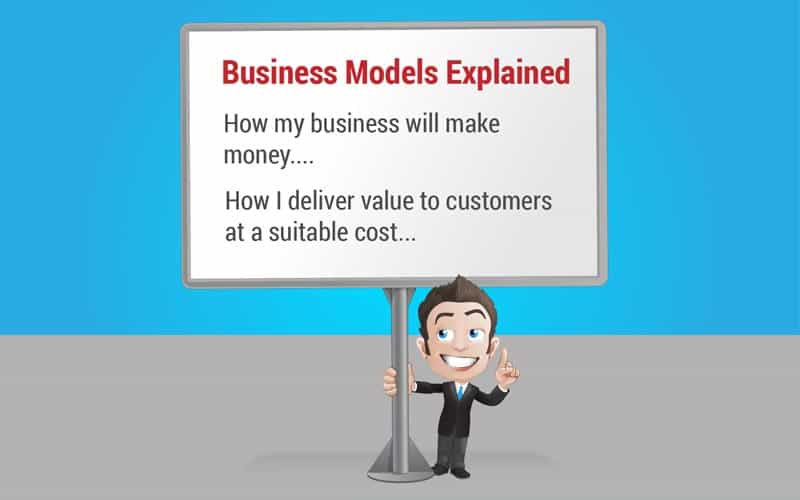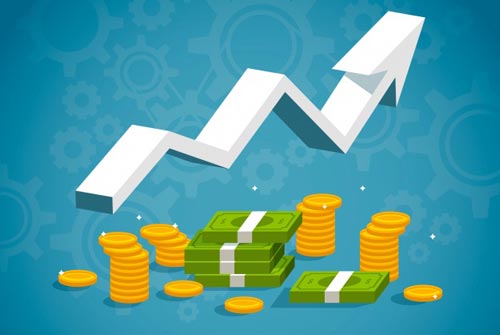Choosing the right Business Model
(Step by Step) Guide

#1 How to create a Business Model – Explained
Understanding your Business Model is key if you want to succeed!
This article will show you how to define your business model, so that you know what you can charge your customers.
Bottom Line:
If you’re not sure how to structure your business…
Read on!

This article is part of the Business Planning Hub, where you’ll find lots of guides and resources to help you create the perfect business plan!
One of the biggest challenges when starting a business is understanding what problem you are solving for your customers.
Your product needs to solve a ‘real’ problem and customers need to ‘want’ what you’re selling.
However, fulfilling your customers market needs is only one part of creating a successful business.
The key ingredient is to work out how you will make your money – hence where the business model comes into effect.
Shall we begin…
#2 The Business Model
Basically, in layman’s terms, a business model describes how your business will make money – a description of how you will deliver value to your customers, at an appropriate cost.
In its simplest form a business model can be broken down into three sections:

- Everything that’s required to create something: such as raw materials, design, labor, manufacturing etc.
- Everything that’s required to sell that particular item: such as distribution, marketing, delivery and processing the sale itself.
- What and how customers pay: such as payment methods, price strategy, payment timing etc.
The biggest issue when starting a business is knowing what problem you’re solving for your customers. Understand your business model & create a successful #business!
A business model basically outlines what expenses and costs you have, together with how much you can charge for a service or product.
Successful business collect more money from their customers than what they’ve spent in making the product.
This is called profit.
Simple…
An effective strategy doesn’t mean that you need to create a new business model. Instead, you could use an existing business with different customers.
An example could be a restaurant – these generally operate using a standard business model, but concentrate their strategy on targeting different types of customers.

Different types of business models for entrepreneurs and start-ups
Need a specific kind of business plan?
Most businesses use an existing business model and simply refine it, rather than creating an entirely new one.
Below you can find a list of a business models that can be used for start-up businesses:
- Advertising – This model involves creating content that people want to watch or read – then displaying it via advertising to viewers or readers. Advertising models need to please two types of customer groups: Viewers/readers and advertisers.
- Affiliate – The affiliate model is similar to the advertising business model, but, instead of visual advertisements, it uses links that are embedded in content. For example, if you have a website that reviews books, you could embed affiliate links to Amazon within the reviews. In this way people will be able to buy the book, and you will be paid a small commission by Amazon.
- Brokerage – Brokerage businesses connect both sellers and buyers as well as help to facilitate sales. Fees are charged per transaction to either party or sometimes both. Common business examples are real-estate agencies.
- Concierge/customization – This is where a business takes an existing service or product and adds in a custom element that then makes each sale unique for each customer. A prime example of this is bespoke travel agents who arrange trips for wealthy clients.
- Crowdsourcing – This is when you are able to bring a large number of people together who then contribute content to your site. This is usually paired together with advertising models in order to generate revenue. Successful crowdsourcing is being able to entice the ‘crowd’ by offering the right rewards while at the same time building a viable business.
- Disintermediation – This is where you bypass everyone in the supply chain and sell directly to consumers, which improves customer relationships and lowers costs.
- Fractionalization – Rather than selling a complete product only parts are sold with this type of model. An example could be a timeshare, where a holiday home is owned by a group of people rather than just one.
- Franchise – This kind of businss model can be found in a lot of service industries, but most commonly in the restaurant industry. A franchise business model is where an individual is selling the knowledge and know-how for starting up and running a successful business onto someone else. It usually includes support services and access to a national brand in order to help the new owner of the franchise get up and running.
- Freemium – This is where either part of a product or service is given away for free and charges are applied for premium services and features.
- Leasing – Very similar to renting, this kind of business model is commonly used for expensive products, whereby a customer may not be able to afford a full purchase, but instead can afford to rent it over a period of time.
- Low-touch – this business model allows companies to keep their prices lower by offering fewer services. Examples of these types of business plans are budget airlines and furniture outlets such as IKEA.
- Marketplace – Marketplaces allow sellers to list items for sale and provide customers with easy tools for connecting to sellers. The marketplace business model can generate revenue from a variety of sources including fees to the buyer or the seller for a successful transaction, additional services for helping advertise seller’s products, and insurance so buyers have peace of mind. The marketplace model has been used for both products and services.
- Pay-as-you-go – This is where customers get billed for usage of something at the end of a billing period rather than pre-purchasing a set amount of something, e.g.: cell phone minutes or electricity.
- Razor blade – This model is named after the product that basically invented it: selling a durable product below cost value to increase the volume of sales of a higher-margin disposable component of the said product. For example, razor blade handles are practically given away by the companies, as they pre-empt that users will, in the long term, continue to buy large amounts of blades.
- Reverse razor blade – This is a turnaround of the razor bland model. A high-margin product is offered, and sales of a low-margin companion product are promoted.
- Reverse auction – This is basically an upside auction. Sellers pitch their lowest prices to their buyers, who then have the option whether to accept them. These are most commonly seen when shopping for a mortgage or loan or when contractors put bids in to carry out construction work.
- Subscription – These are very common and is where consumers are charged a subscription fee to gain access to a service. Aside from magazine and newspaper subscriptions, the model has now moved to online and software services and even within the service industries.
Of course, there are other business models in existence – but this will give you an idea of how to structure your business.
The key ingredient when working out your #business #model is how you are going to make money. Check out these business models and apply them to your business
Remember, you don’t need to invent a new business model when starting up a new business – existing models are perfect as they have been proven to be successful.
That said, a new model could be very lucrative – but keep in mind that it also poses higher risks because it’s untested, so you don’t know if customers will readily accept the model or not.
Now, over to you...
Now I’d love to hear from you:
Are you still unsure of which business plan you need?
Maybe you have written a business plan and would like us to review it?
Leave any comments below and I will be sure to answer as soon as they come in!




